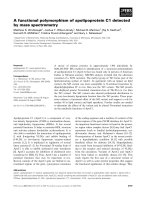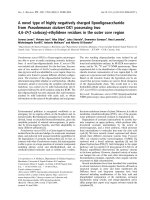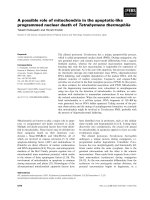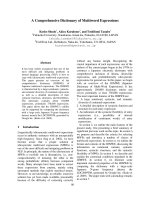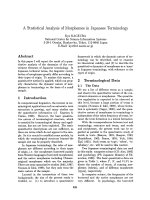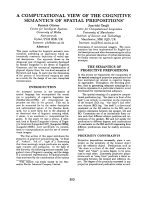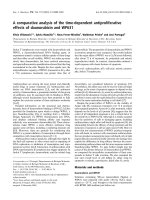Báo cáo khoa học: "A Computational Analysis of Complex Noun Phrase in Messages" docx
Bạn đang xem bản rút gọn của tài liệu. Xem và tải ngay bản đầy đủ của tài liệu tại đây (337.8 KB, 4 trang )
A Computational Analysis of
Complex Noun
Phrmms in N,,vy
Messages
Elaine Marsh
Navy Center for Applied Research in Artificial Intelligence
Naval Research Laboratory - Code 7510
Washington, D.C. 20375
ABS TRACT
Methods of text compression in Navy messages are
not limited to sentence fragments and the omissions of
function words such as the copula
be.
Text compression
is also exhibited within ~grammatieal" sentences and is
identified within noun phrases in Navy messages.
Mechanisms of text compression include increased fre-
quency of complex noun sequences and also increased
usage of nominalizations. Semantic relationships among
elements of a complex noun sequence can be used to
derive a correct bracketing of syntactic constructions.
I INTRODUCTION
At the Navy Center for Applied Research in
Artificial Intelligence, we have begun computer-analyzing
and processing the compact text in Navy equipment
failure messages, specifically equipment failure messages
about electronics and data communications systems.
These messages are required to be sent within 24 hours of
the equipment casualty. Narrative remarks are restricted
to a length of no more than 99 lines, and each line is res-
tricted to a length of no more than 69 characters.
Because hundreds of these messages are sent daily to
update ship readiness data bases, automatic procedures
are being implemented to handle them efficiently. Our
task has been to process them for purposes of dissemina-
tion and summarization, and we have developed a proto-
type system for this purpose. To capture the information
in the narrative, we have chosen to use natural language
understanding techniques developed at the Linguistic
String Project [Sager 1981].
These messages, like medical reports [Marsh 1982]
and technical manuals [Lehrberger 1982], exhibit proper-
ties of text compression, in part due to imposed time and
length constraints. Some methods of compression result
in sentences that are usually called
ill-formed
in normal
English texts [Eastman 1981]. Although unusual in nor-
mal, full English texts, these are characteristic of mes-
sages. Recent work on these properties' include discus-
sions of omissions of function words such as the copula
be,
which results in sentence fragments and omissions of
articles in compact text [Marsh 1982, 1983; Bachenko
1983]. However, compact text also utilizes mechanisms of
compression that are present in normal English but are
used with greater frequency in messages and technical
reports. Although the messages contain sentence frag-
ments, they also contain many complete sentences.
These sentences are long and complicated in spite of the
telegraphic style often used. The internal structure of
noun phrases in these constructions is often quite com-
plex, and it is in these noun phrases that we find syntac-
tic constructions characteristic of text compression. Simi-
lar properties have been noted in other report sub-
languages [Lehrberger, 1982; Levi, 1978].
When processing these messages it becomes impor-
tant to recognize signs of text compression since the func-
tion words that so often direct a parsing procedure and
reduce the choice of possible constructions are frequently
absent. Without these overt markers of phrase boun-
daries, straightforward parsing becomes difficult and
structural ambiguity becomes a serious problem. For
example, sentences (1)-(2) are superficially identical, how-
ever in Navy messages, the first is a request for a part (an
antenna)
and the second a sentence fragment specifying
an antenna performing a specific function. (a
transmit
antenna).
(1) Request antenna shipped by fastest available means.
(2) Transmit antenna shipped by fastest available
means.
The question arises of how to recognize and capture these
distinctions. We have chosen to take a sublangnage, or
domain specific, approach to achieving correct parses by
specifying the types of possible combinations among ele-
ments of a construction in both structural and semantic
terms.
This paper discusses a method for recognizing
instances of textual compression and identifies two types
of textual compression that arise in standard and sub-
language texts: complex noun sequences and nominaliza-
tions. These are both typically found in noun phrase
constructions. We propose a set of semantic relations for
complex noun sequences, within a sublanguage analysis,
that permits the proper bracketing of modifier and host
for correct interpretation of noun phrases.
II TEXT COMPRESSION IN NOUN PHRASES
We can recognize the sources of text compression by
two means: (1) comparing a full grammar of the standard
language to that of the domain in which we are working,
505
and {2) comparing the distribution of constructions in
two different sublanguages. The first comparison distin-
guishes those constructions that are peculiar to a sub-
language /el. Marsh 1982]. A comparison of a full gram-
mar with two sublanguage grammars, the equipment
failure messages discussed here and a set of patient medi-
cal histories, disclosed that the sublanguage grammars
were substantially smaller than full English grammars,
having fewer productions and reflecting a more limited
range of modifiers and complements [Grishman 1984].
The second comparison identifies the types of construc-
tions that exhibit text compression. These are common
even in full sentences. For example, we found that simi-
lar sets of modifiers were used in the two different sub-
languages [Grishman 1984]. However, the equipment
failure messages had significantly more left and right
modifier constructions than the medical, even though the
equipment failure messages had about one-half the
number of sentences of the patient histories. 236 sen-
tences in the medical domain were analyzed and 123 in
the Navy domain. The statistics are presented in Tables
1 and 2.
In particular, there were significantly more noun
modifiers of nouns constructions (Noun + Noun construc-
tions) in the equipment failure messages than there were
in the medical records, and more prepositional phrase
modifiers of noun phrases. Further analysis suggested
these constructions are symptomatic of two major
mechanisms text compression in Navy messages: of com-
plex noun sequences and nominalizations.
Complex noun sequences. A major feature of noun
phrases in this set of messages is the presence of many
long sequences of left modifiers of nouns, (3).
{3) (a) forward kingpost sliding padeye unit
(b) coupler controller standby light
(c) base plate insulator welds
{d) recorder-reproducer tape transport
(e)
nbsv or ship-shore tty sat communications
(f) fuze setter extend/retract cycle
Complex noun sequences like these can cause major prob-
lems in processing, since the proper bracketing requires
an understanding of the semantic/syntactic relations
between the components. [Lehrberger 1982] identifies
similar sequences (empilage) in technical manuals. As he
notes, this results from having to give highly descriptive
names to parts in terms of their function and relation to
other parts.
Modifiers of nouns include nouns and adjectives. In
Type
Total noun phrases
Articles
Left Modifiers of Nouns
Navy
339
27
72
4
[ Medical
532
38
Adjectival Modifiers:
Adj
Adj + Adj
Possessive N
138
34
4 0
Noun Modifiers:
Noun 99 76
N+N 25 4
Verb 7 0
Table I: Left Modifier Statistics
Right Modifiers of Nouns
Type [ Navy [ Medical
Prepositional Phrases 95 107
Relative Clauses 1 5
Adverb 4 0
Reduced Relative Clauses 7 9
Table 2: Right Modifier Statistics
506
the sublanguage of Navy messages, unmarked verb
modifiers of nouns also occur. This construction is not
common in standard English or in the medical record
sublanguage mentioned above. It is illustrated above in
(2) and below in (4).
(4) (a) receive sensitivity
(b) operate mode
(c) transmit antenna
Because the verbs are unmarked for tense or aspect, they
can be mistaken by the parsing procedure for imperative
or present tense verbs. Furthermore, in this domain the
problem is compounded by the frequent use of sentence
fragments consisting of a verb and its object, with no
subject present (1) repeated as (5) below.
(5) Request antenna
Complex noun sequences also commonly arise from
the omission of prepositions from prepositional phrases.
The resulting long sequences of nouns are not easily
bracketed correctly. In this data set, the omission of
prepositions is restricted to place and time sequences (6-
7).
(6) Request NAVSTA Guantanamo Bay Cuba coordi-
nate
Request RSG Mayport arrange
(7) Original antenna replaced by outside contractor
through RSG Mayport 7 JUN 82.
In (6), prepositions marking time phrases have been omit-
ted, and in (7) both time and place prepositions have
been omitted.
Nominalizations.
The increased frequency of preposi-
tional modifiers in the equipment failure messages was
traced to the frequent use of nominalizations in Navy
messages. Out of a preliminary set of 89 prepositional
modifiers of nouns, 42 were identified as arguments to
nominalized verbs (47%), the other 52% were attributive.
Examples of argument prepositional phrases are given in
(8), attributive in (9).
(8) (a) assistance from MOTU 12
(b) failure of amplifier
(c) cause of casualty
(d) completion of assistance
(9) (a) short circuit between amplifier and power supply
(b) short in cable
(c) receipt NLT 4 OCT 82
(d) burned spots on connector
In these texts, in which nominalization serves as an
important mechanism of text compression, it therefore
becomes important to distinguish prepositional phrases
that serve as arguments of nominalizations from
attributive ones.
The syntax of complex modifier sequences in noun
phrases and the identification of nominalizations, both
characteristic of text compression, need to be consistently
defined f~,~ ~ r)roper understanding of the text being pro-
cessed. By utilizing the semantic patterns that are
derived from a sublanguage analysis, it becomes possible
to properly bracket complex noun phrases. This is the
subject of the next section.
HI SEMANTIC PATTERNS IN
COMPLEX NOUN SEQUENCES
Noun phrases in the equipment failure messages typ-
ically include numerous adjectival and noun modifiers on
the head, and additional modifier types that are not so
common in general English. The relationships expressed
by this stacking are correspondingly complex. The
sequences are highly descriptive, naming parts in terms of
their function and relation to other parts, and also
describing the status of parts and other objects in the
sublanguage. Domain specific information can be used to
derive the proper bracketing, but it is first necessary to
identify the modifier-host semantic patterns through a
distributional analysis of the texts. The basis for sub-
language work is that the semantic patterns are a res-
tricted, limited set. They talk about a limited number of
classes and objects and express a limited number of rela-
tionships among these objects. These objects and rela-
tionships are derived through distributional analysis, and
can ultimately be used to direct the parsing procedure.
Complex noun sequences.
Semantic patterns in complex
noun phrases fall into two types: part names and other
noun phrases. Names for pieces of equipment often con-
tain complex noun sequences, i.e. stacked nouns. The
relationships among the modifiers in the part names may
indicate one of several semantic relations. They may
indicate the levels of components. For example,
assembly/component relationships are expressed. In
cir-
cuit diode, diode
is a component of a
circuit.
In
antenna
coupler, coupler
is a component part of an
antenna.
Part
names may also describe the function of the piece of
equipment. For example, in the phrase
high frequency
transmit antenna, trqlnsmit is
the function of the
antenna.
The semantic relations among the modifiers of a part are
strictly ordered are shown in (10a); examples are provided
in (10b).
(10) (a) ID REPAIR SIGNAL FUNCTION PART.
(b)
CU-t~O07 antenna coupler; HF XMIT antenna;
deflection amplifier; UYA. 4 display system; primary
HF receive antenna
The component relations in part names are especially
closely bound and are best regarded as a unit for process-
ing. Thus
antenna coupler in CU-~O07 antenna coupler
can be considered a unit. We would not expect to find
antenna CU-~O07 coupler
or
coupler CU-~007 antenna.
In other noun phrases, i.e. those that are not part
names, the head nouns can have other semantic
categories. For example, looking back at the sentences in
(3), the head noun of a noun sequence can be an equip-
ment part (
unit, light
), a process that is performed on
electrical signals (
cycle
), a part function (communica-
507
tions ). In addition, it can be a repair action (alignment,
repair), an assistance actions ( assistance ), and so on.
Only modifiers with appropriate semantic and syntactic
category can be adjoined. For example, in the phrase fuze
setter eztend/retract cycle, semantic information is neces-
sary to attain the correct bracketing. Since only function
verbs can serve as noun modifiers, eztend/retraet can be
analyzed as a modifier of cycle, a process word. Fuze
setter, a part name, can be treated as a unit because
noun sequences consisting of part names are generally
local in nature. Fuze setter is prohibited from modifying
eztend/retract, since verb modifiers do not themselves
take noun modifiers.
Other problems, such as the omissions of preposi-
tions resulting in long noun sequences (ef. (8) and (0)
above), can also be treated in this manner. By identify-
ing the semantic classes of the noun in the object of the
prepositionless prepositional phrase and its host's class,
the occurrence of these prepositionless phrases can he res-
tricted. The date and place strings can then be properly
treated as a modifier constructions instead as head nouns.
IV CONCLUSION
Methods of text compression are not limited to omis-
sions of lexical items. They also include mechanisms for
maximizing the amount of information that can he
expressed within a limited time and space. These
mechanisms include increased frequency of complex noun
sequences and also increased usage of nominalizations.
We would expect to find similar methods of text compres-
sion in other types of scientific material and message
traffic. The semantic relationships among the elements of
a noun phrase permit the proper bracketing of complex
noun sequences. These relationships are largely domain
specific, although some patterns may be generalizable
across domains [Marsh 1084 I.
The approach taken here for Navy messages, which
uses suhlanguage seleetional patterns for disambiguation,
was developed, designed, and implemented initially at the
New York University Linguistic String Project for medi-
cal record processing [Friedman 1984; Grishman 1983;
Hirschman 1982 I. It was implemented with the capability
for transfer to other domains. We anticipate using a
similar mechanism, based partially on the analysis
presented here, on Navy messages in the near future.
References
[Baehenko 1983] Bachenko, J. and C.L. Heitmeyer. Noun
Phrase Compression in Navy Messages. NRL Report
8748.
[Eastman 1981]. Eastman, C.M. and D.S. McLean. On the
Need for Parsing Ill-Formed Input. AJCL 7 (1981),4.
[Friedman 1984] Friedman, C. Suhlanguage Text Process-
ing - Application to Medical Narrative. In [Kittredge
1084].
[Grishman 10831 Grishman, R., Hirsehman, L. and C.
Friedman. Isolating Domain Dependencies in Natural
Language Interfaces. Proc. o/ the Con/. on Applied Nat.
Lang. Processing (ACL).
[Grishman 1984] Grishman, R., Nhan, N, Marsh, E. and
L. Hirschman. Automated Determination of Suhlanguage
Syntactic Usage. Proc. COLING 84) (current volume).
[Hirschman 1082] Hirsehman, L. Constraints on Noun
Phrase Conjunction: A Domain-independent
Mechanism.Proc. COLING 8~ - Abstracts.
~ittredge 1984] Kittredge, R. and R. Grishman.Proc. of
the Workshop on Sublanguage Description add Processing
{held January 19-20, 1084, New York University, New
York, New York), to appear.
[Lehrberger 1982]. Lehrberger, J. Automatic Translation
and the Concept of Sublanguage. In Kittredge and
Lehrberger (eds), Sublanguage: Studies of Language in
Restricted Semantic Domains. de Grnyter New York,
1082.
[Levi 1078] Levi, J.N. The Syntaz and Semantics of Com-
plez Nominals, Academic Press, New York.
[Marsh 1982]. Marsh, E. and N. Sager. Analysis and Pro-
cussing of Compact Text. Proc. COLING 82, 201-206,
North Holland.
[Marsh 1083] Marsh, E. Utilizing Domain-Specific Infor-
mation for Processing Compact Text. Proc. Conf. Applied
Natural Language Processing, 09-103 (ACL).
[Marsh 1084] Marsh E. General Semantic Patterns in
Different Sublanguages. In [Kittredge 1084].
[Sager 1081] Sager, N. Natural Language Information Pro-
cessing. Addison-Wesley, Reading, MA.
Acknowledgments
This research was supported by the Oflace of Naval
Research and the Ofllce of Naval Technology PE-62721N.
The author gratefully acknowledges the efforts of Joan
Bachenko, Judy Froseher, and Ralph Grishman in pro-
ceasing the initial corpus of Navy messages, and the
efforts of the researchers at New York University in pro-
cussing the medical record corpus.
508

